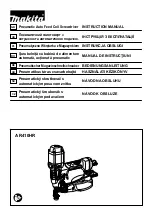
8
catching.
•
On rooftops and other high locations, drive
fasteners as you move forward. It is easy to lose
your footing if you drive fasteners while inching
backward. When driving fasteners against
perpendicular surface, work from the top to the
bottom. You can perform driving operations with
less fatigue by doing so.
•
A fastener will be bent or the tool can become
jammed if you mistakenly drive fastener on top of
another fastener or strike a knot in the wood. The
fastener may be thrown and hit someone, or the
tool itself can react dangerously. Place the
fasteners with care.
•
Do not leave the loaded tool or the air compressor
under pressure for a long time out in the sun. Be
sure that dust, sand, chips and foreign matter will
not enter the tool in the place where you leave it
setting.
•
Never attempt to drive fasteners from both the
inside and outside at the same time. Fasteners
may rip through and/or fly off, presenting a grave
danger.
Service
•
Perform cleaning and maintenance right after
finishing the job. Keep the tool in tip-top condition.
Lubricate moving parts to prevent rusting and
minimize friction-related wear. Wipe off all dust
from the parts.
•
Ask Makita authorized service center for periodical
inspection of the tool.
•
To maintain product SAFETY and RELIABILITY,
maintenance and repairs should be performed by
Makita Authorized Service Centers, always using
Makita replacement parts.
SAVE THESE INSTRUCTIONS.
WARNING:
DO NOT let comfort or familiarity with product
(gained from repeated use) replace strict adherence
to safety rules for the subject product. MISUSE or
failure to follow the safety rules stated in this
instruction manual may cause serious personal
injury.
INSTALLATION
Selecting air hose
Fig.1
Use a high pressure resistant air hose.
Use an air hose as large and as short as possible to
assure continuous, efficient screw-driving operation.
CAUTION:
•
Low air output of the compressor, or a long or
smaller diameter air hose in relation to the screw-
driving frequency may cause a decrease in the
driving capability of the tool.
Lubrication
Before and after use, oil the tool with pneumatic tool oil
by placing two or three drops into the air fitting. For
proper lubrication, the tool must be fired a couple of
times after pneumatic tool oil is introduced.
Fig.2
FUNCTIONAL DESCRIPTION
CAUTION:
•
When adjusting driving depth, always lock the
trigger and disconnect the air hose.
Adjuster (drive depth adjuster) Operating
Method
Fig.3
Fig.4
CAUTION:
•
When adjusting driving depth, always lock the
trigger and disconnect the air hose.
This driver is equipped with an adjuster for adjusting
screw driving depth.
Turn the adjuster to adjust driving depth. Driving
adjustment range is 6mm. (one turn of adjuster adjusts
depth by approximately 0.8mm.)
Hook
CAUTION:
•
When using the hook, or changing its position,
always lock the trigger, and disconnect the air
hose.Do not fasten hook onto waist belt, etc.
•
If hook becomes unfastened and the driver drops,
driver may operate by mistake, and lead to injury.
Fig.5
The hook is useful for hanging up the driver temporarily.
The mounting position of the hook on the driver can be
changed.
Remove the hook mounting screw, change position of
hook, and re-secure screw.
Switcher Mode Selection
Fig.6
This driver is equipped with a switcher to enable
selection of mode for optimum driving according to the
material of the workpiece.Set to mode positions shown
in "Switching Mode Chart" below for optimum
use.Thoroughly turn the knob until it clicks to a halt
properly at either position (1) or (2).If the driver is used
with the switcher in a position between (1) and (2),
driver components may become damaged, and/or
normal performance not achieved.









































